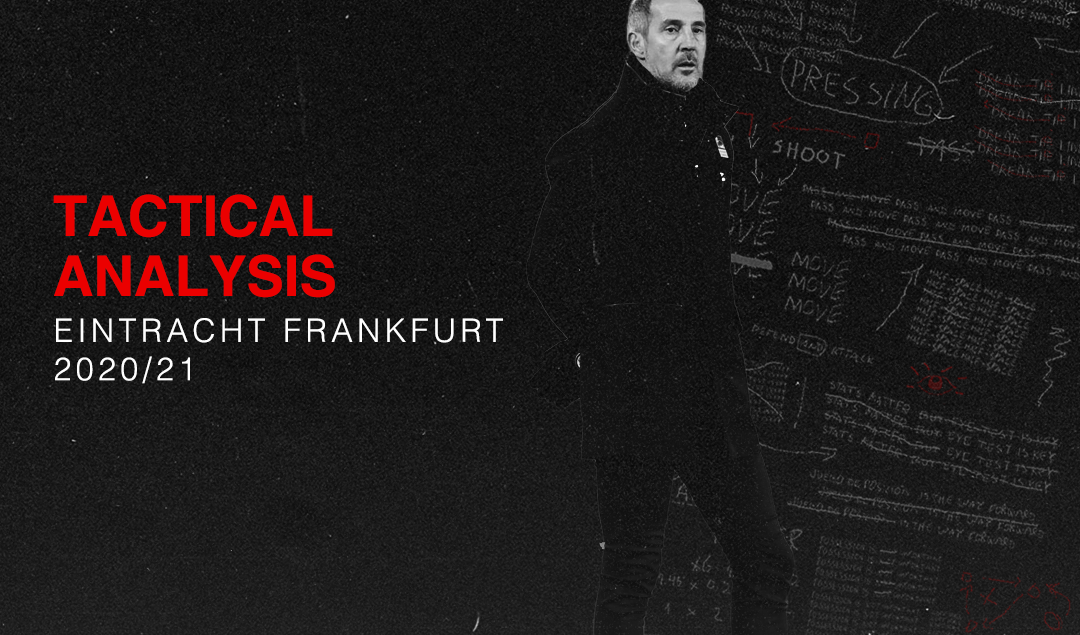Tactical Analysis: Adi Hütter’s Eintracht Frankfurt
Eintracht Frankfurt fans fondly remember the 2018/19 season when Adi Hütter introduced his high tempo attacking style of football at the Deutsche Bank Park and qualified Frankfurt for the following season’s Europa League. The Austrian manager has since seen several players come and go but he continues to challenge for a place in European competitions.
The Making of Adi Hütter: Exceeding Expectations in Austria and Ending Years of Hurt in Switzerland
This season, the Eagles have claimed their stakes for the Champions League qualification contention as they currently sit three points clear on the fourth position in the Bundesliga. They are on course to qualify for the elite competition for the first time in 62 years.
Die Adler endured a slow start to the current Bundesliga campaign as the initial 12 games saw them winning just twice. However, their season has come alive since then as the next 12 games have produced 10 victories, including the one against the champions and current leaders Bayern Munich. In this analysis, we will delve into the attacking as well as defensive tactics and philosophy of Hütter’s Frankfurt that has made them so impressive this season.
Build-up principles
Barring one game, Frankfurt has played with the 3-4-3 system and its variants throughout the season. In his three-at-the-back system, Hütter prefers attacking wingbacks who are tasked to provide depth higher up the field. Hence, their buildup shape often transitions from a 3-4-3 to a 3-2-5, as shown in the following figure.

The Austrian manager puts a lot of emphasis on creating the width in the buildup. The higher positioning of the wingbacks means that the onus on providing the width during the first phase rests on the centre-backs or the pivots. Typically, the three chains of centre-backs stretch horizontally to create the width while the pivots stay central to provide passing support, as shown in the above image.
Hütter also provides the players with freedom and flexibility in their positioning and movements. The following figure shows an instance where Sebastian Rode, who is the left-sided defensive midfielder, has dropped into the left centre-back position for passing support, as the two wide centre-backs are providing the width on both the sides.

In another instance of the same game, the right-sided pivot, Stefan Ilsanker, has dropped slightly deeper and wider on the right since the right-sided central defender David Abraham has tucked into the centre to provide support for his centre-back partner. Rode, who dropped deep in the previous image, has stayed high and central as the lone pivot this time.

This kind of positional freedom provided to the players assists the team to counter different oppositions and their tactical tweaks within a game. Besides, it also helps Frankfurt to create numerical superiority against the opposition’s initial line pressure. Along with width, numerical superiority is another important principle that Hütter demands from his team during the build-up phase.
The following figure shows how Hütter’s men gain a 3v2 advantage against Borussia Mönchengladbach’s initial line of pressure by dropping a pivot between the two central defenders. Observe that the shape of the team still provides the width.
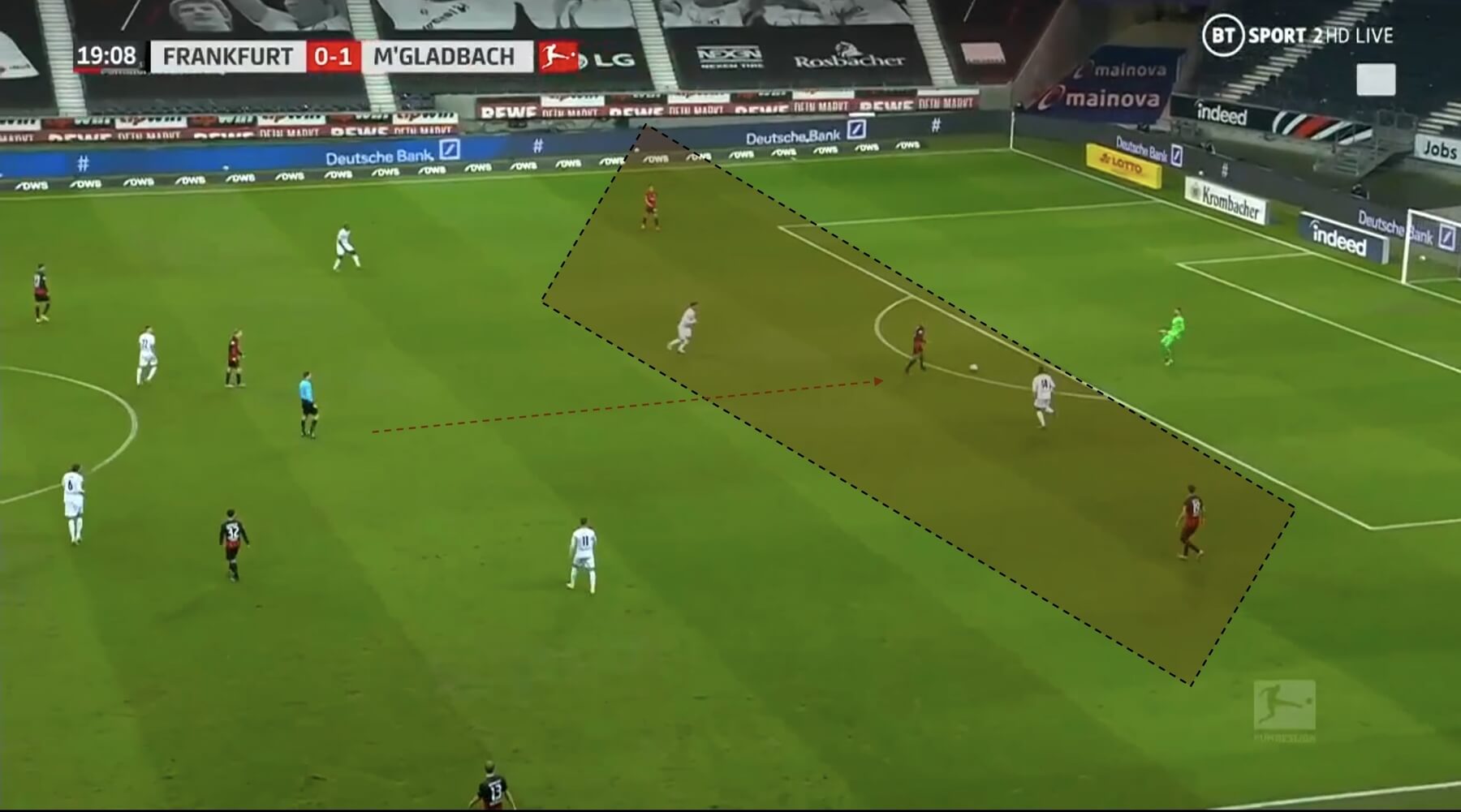
Vertical Progression
Hütter prefers to play a bold and exciting brand of attacking football that starts with a patient buildup and is followed by a quick vertical progression through the thirds to enter into the opposition box. Eintracht have scored in every game of the season barring just one and currently sit third in terms of the total goals scored (47) in Bundesliga. The nature of their vertical progression can be divided into three phases, as we shall see in this section.
Phase 1 – Patient Build-up
The expansive shape, along with the numerical superiority at the back allows Hütter’s men to preserve possession and patiently distribute the ball from side-to-side during the buildup phase. This kind of lateral rotation of the possession not only helps Frankfurt to create gaps between the opposition’s horizontal lines but also it has potential to create vertical space between the lines if the opposition’s initial line pushes higher to press.
Once Eintracht Frankfurt can create such spaces, one of their defenders would look to make a pass into the opposition half that would break the central lines. The following scenario from their 3-3 draw against Union Berlin demonstrates the tactic.
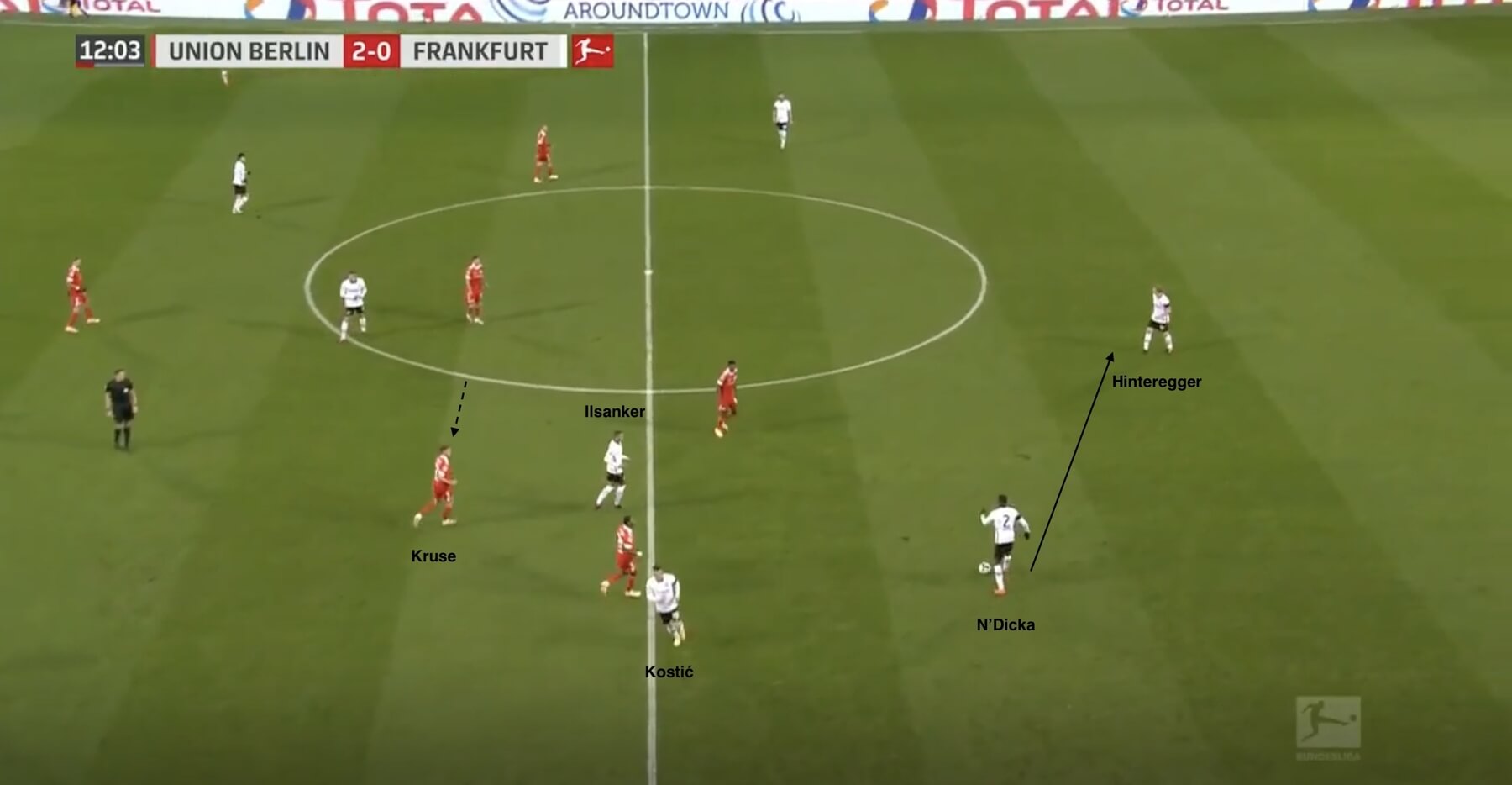
Filip Kostić and Ilsanker have dragged Max Kruse slightly wide into the half-space. Evan N’Dicka quickly realized this and relayed the possession to Martin Hinteregger. Before Kruse could return to his position to close the lateral space, Hinteregger broke Berlin’s central line and his pass found Bas Dost (not in the image), who dropped between the opposition lines.
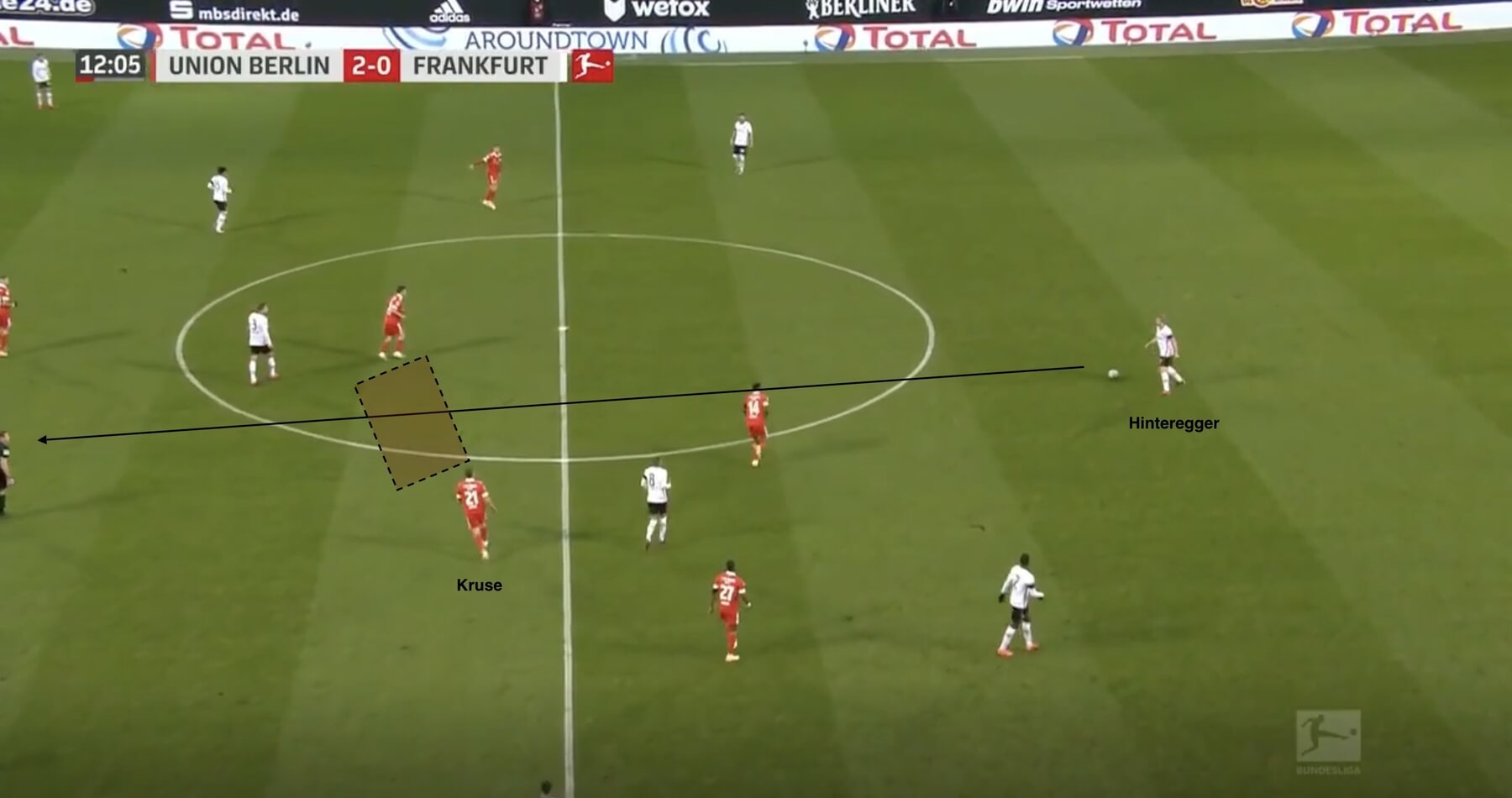
Considering their ball-playing capabilities, Frankfurt’s centre-backs are granted a lot of creativity in possession by their manager. Hence, even though they prefer to progress the ball centrally, they also can make the line-breaking passes from the wider areas.

The above snapshot is taken from the same game as that of the previous example. Observe that this time, Hinteregger’s inside movement have compressed Berlin’s shape. Hence, the defender is denied the option to break the lines from the centre. However, while closing the central space, Berlin has opened up space on the outside.
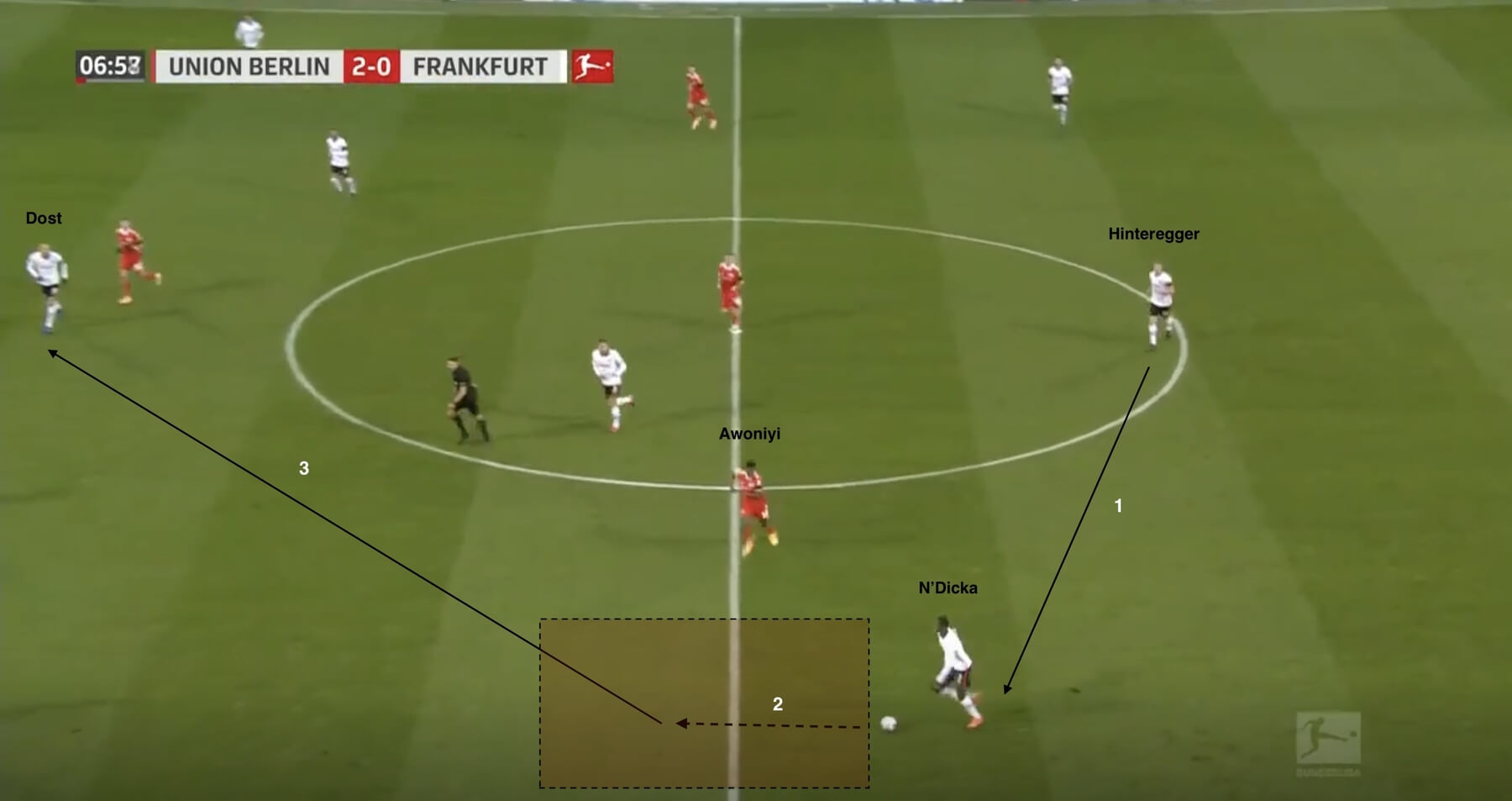
N’Dicka’s wide positioning meant that he was able to receive Hinteregger’s pass with the space in front of him. Before Michael Awoniyi could press N’Dicka, the latter was able to make a line-breaking diagonal ball towards Dost, who once again dropped into the space between the lines.
Hinteregger is a key figure at the back as he constantly makes this kind of passes with both his feet from central as well as wider areas. He has made 4.30 progressive passes and 4.03 passes into the final third per 90 minutes. These are impressive figures for a centre-back.
Frankfurt’s multi-dimensional ability to progress the ball from the first phase creates a foundation for their penetration, as we shall see in the next phase. Hütter’s men average 52.1% possession this season. Only four teams average more possession than them in the Bundesliga. Having said that, Frankfurt’s patient possession-based buildup in their half contributes to most of their possession.
Phase 2 – Central Interplay
Once the ball is played vertically into the feet of an attacker between the opposition lines, it makes the opposition defense disorganized and uncomfortable because it not only creates space between the opposition’s vertical block but also it forces the opposition midfielders to run back towards their own goal instead of shifting laterally.
Moreover, the central line-breaking passes naturally attract the opposition towards the centre which forces them to compress their shape in a compact block. This, in turn, results in space creation in the outside channel.
Hütter’s men intend to take the advantage of this by increasing the speed of their penetration from this point. They prefer to create linkup play between the lines in the centre which is followed by creating third-man situations to release the wing-back behind the opposition full-back in the outside space.
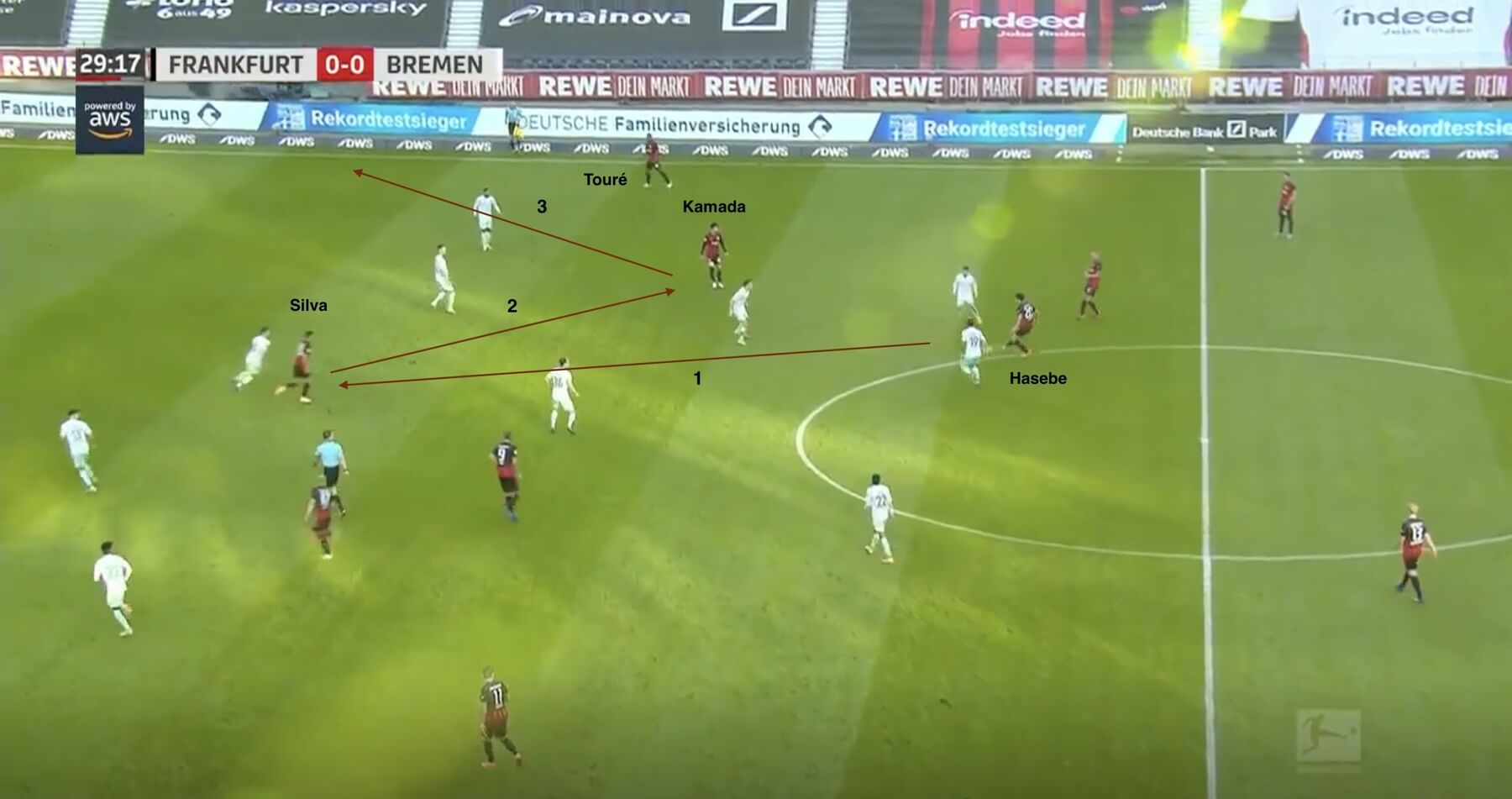
In the figure above, as André Silva drops between the lines to receive Makoto Hasebe’s pass, he provides a one-touch lay-off for Daichi Kamada, who has found space in the inside channel and facing the opposition goal. As the Japanese midfielder receives the ball, he progresses the ball into the final third for Almamy Touré on the right flank.
In Silva and Luka Jović, Frankfurt has two strikers who have an impressive ability to hold the ball up in the central areas. Earlier during the season, it was Dost instead of Jović, who had similar capabilities. According to FBref, Silva has been a target to receive a pass 59.7 times per 90 minutes, which is better than any other striker in Bundesliga.
Kamada is another player who plays a key role during this phase. The playmaker excels in finding spaces all the over the field. Besides, has superior first touch and agility which makes him the perfect player to linkup centrally in the tight spaces between the opposition lines.
Moreover, he has excellent vision and passing ability that makes him a threat whenever he receives the ball facing the opposition goal and have the attackers running behind an opposition defense. The midfielder has provided eight assists so far in the league at the rate of 0.62 assists per 90 minutes, only behind two other midfielders.
Phase 3 – Crosses
In the final third, most of the Frankfurt attacks come in the form of crosses from the wide areas into the box. The Eagles have completed 2.92 crosses (per 90 minutes) inside the penalty area so far in the Bundesliga, only behind Bayern Munich. In the crossing situations, Hütter instructs his side to infiltrate more bodies.
Typically, they would have four bodies in the 18-yard box which would include the front three attackers and the far-sided wing-back. In the following figure, observe that Kostić has made an inside-run to get into the box during a crossing situation.
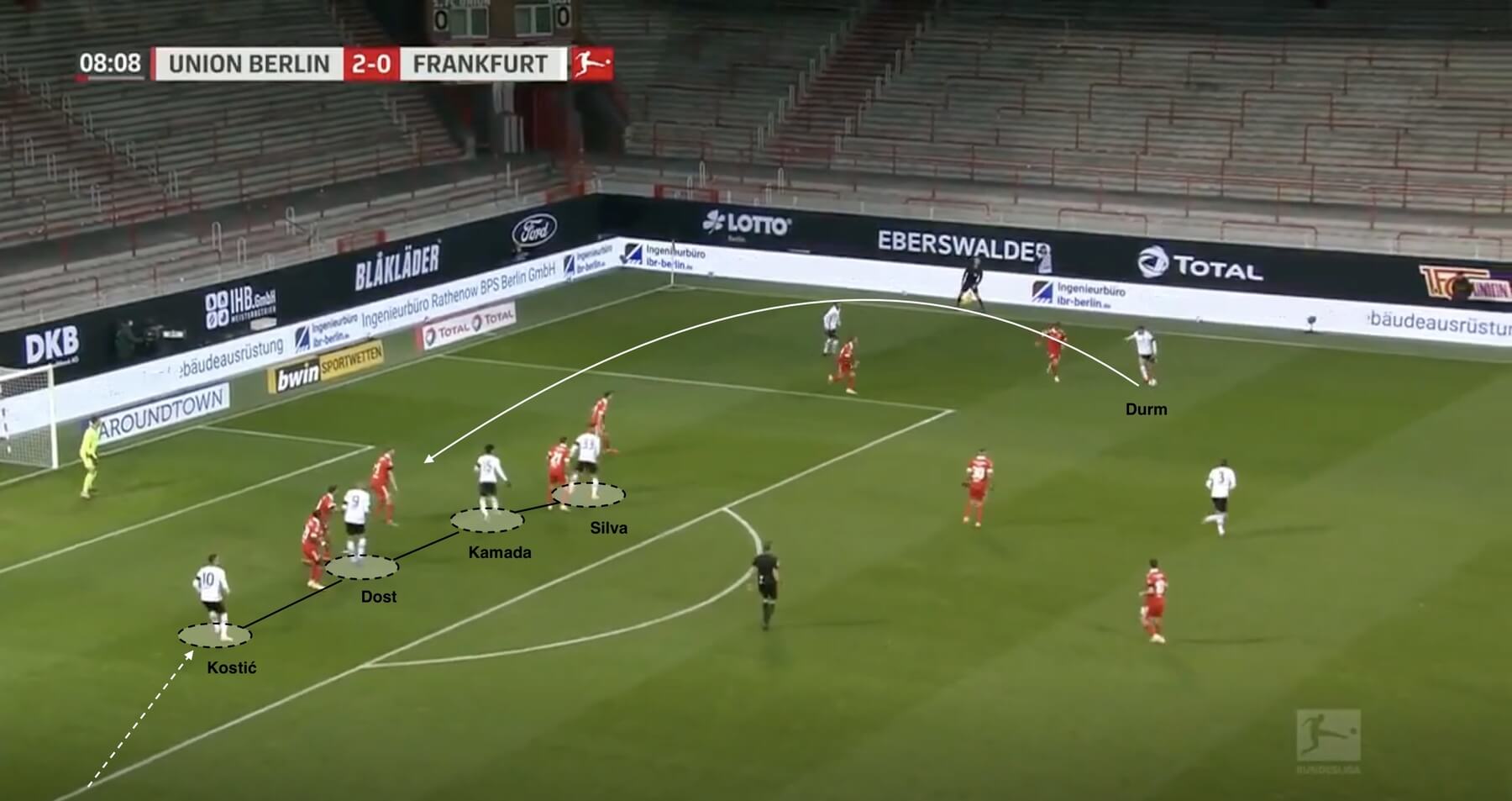
The wingbacks play a crucial role in the final third as one of them is responsible to put a threating cross in the box while the other gets inside the box to threaten the goal. The following dashboard of Kostić highlights the wingback’s attacking role in the final third.
In addition to the following numbers, Kostić also has the highest number of touches inside the penalty area. All the statistics are compared against the defenders who have played at least 1000 minutes in the Bundesliga.
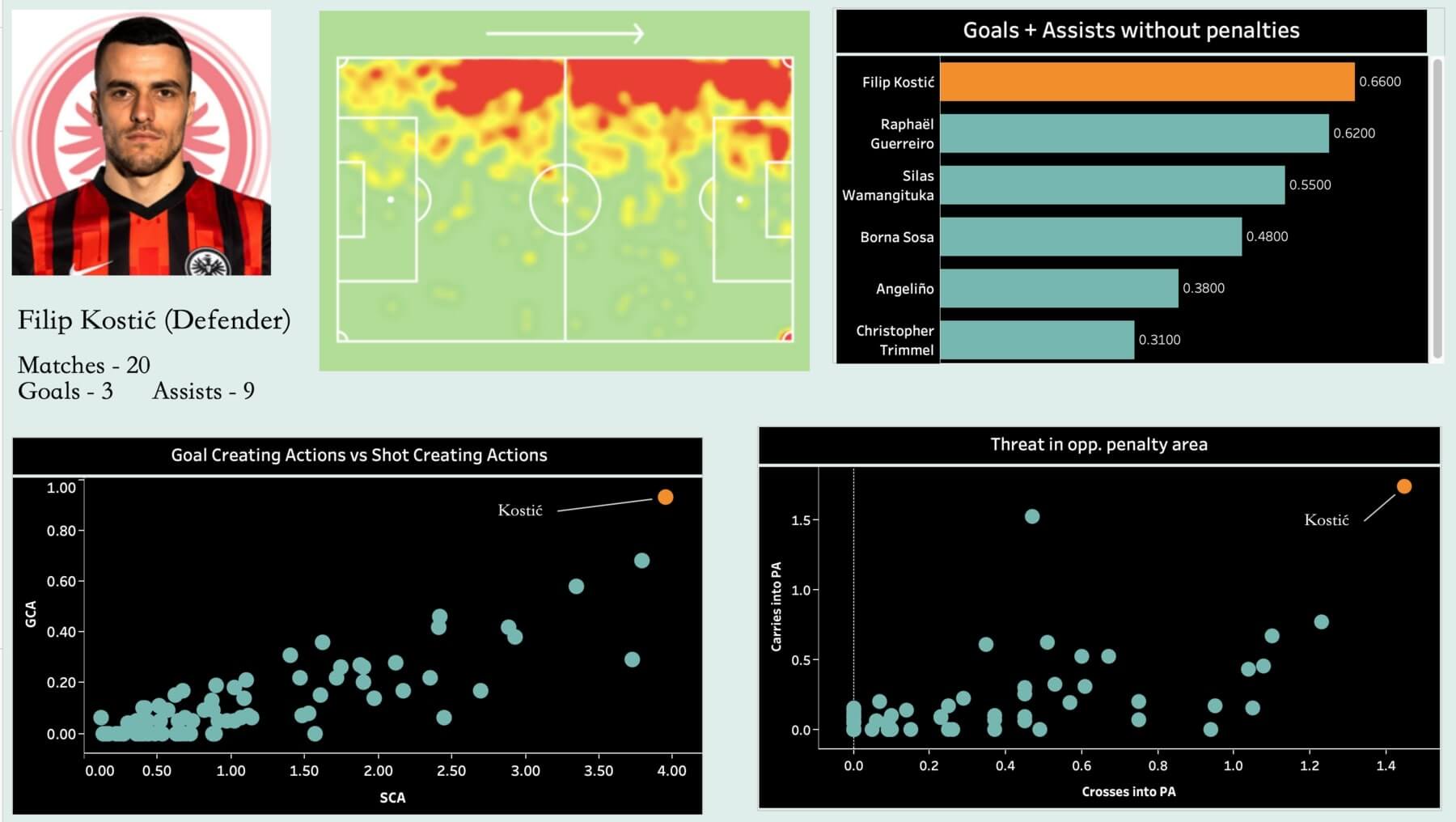
Photo: FBref.com
Another key player in the final third is Silva. The striker has a knack of finding spaces inside the penalty area and excels in playing over the shoulder of opposition defenders which is why he has scored 19 goals in the Bundesliga so far. Only Robert Lewandowski has scored more goals than the Portuguese striker.
Frankfurt’s attack relies on their patient buildup in the first phase as they maintain most of the possession in that phase. This tactic works well against sides that do not press high and rather maintain a compact defensive block without the ball.
However, the Eagles often struggle to keep hold of the ball and form their attacks against sides that are set up in an effective high pressing system. In such games, Hütter prefers plan ‘B’, which is to play more direct and rely on counterattacks to produce goal-scoring opportunities.
The sides like Bayern Munich, RB Leipzig, Borussia Dortmund, Wolfsburg, Leverkusen, and Gladbach are effective high pressing sides. Frankfurt have had an average of mere 40% possession against those sides. On the other hand, Hütter’s men have enjoyed, on average, around 60% possession against the other teams.
Pressing
A lot of modern-day managers set up their teams to press the opposition higher up the pitch and maintain a high defensive line. High pressing is the “defending from the front” tactic which gives the pressing team a chance to win the ball back as high and as early as possible. Hütter is an advocate of this tactic and it is evident in his Frankfurt team.
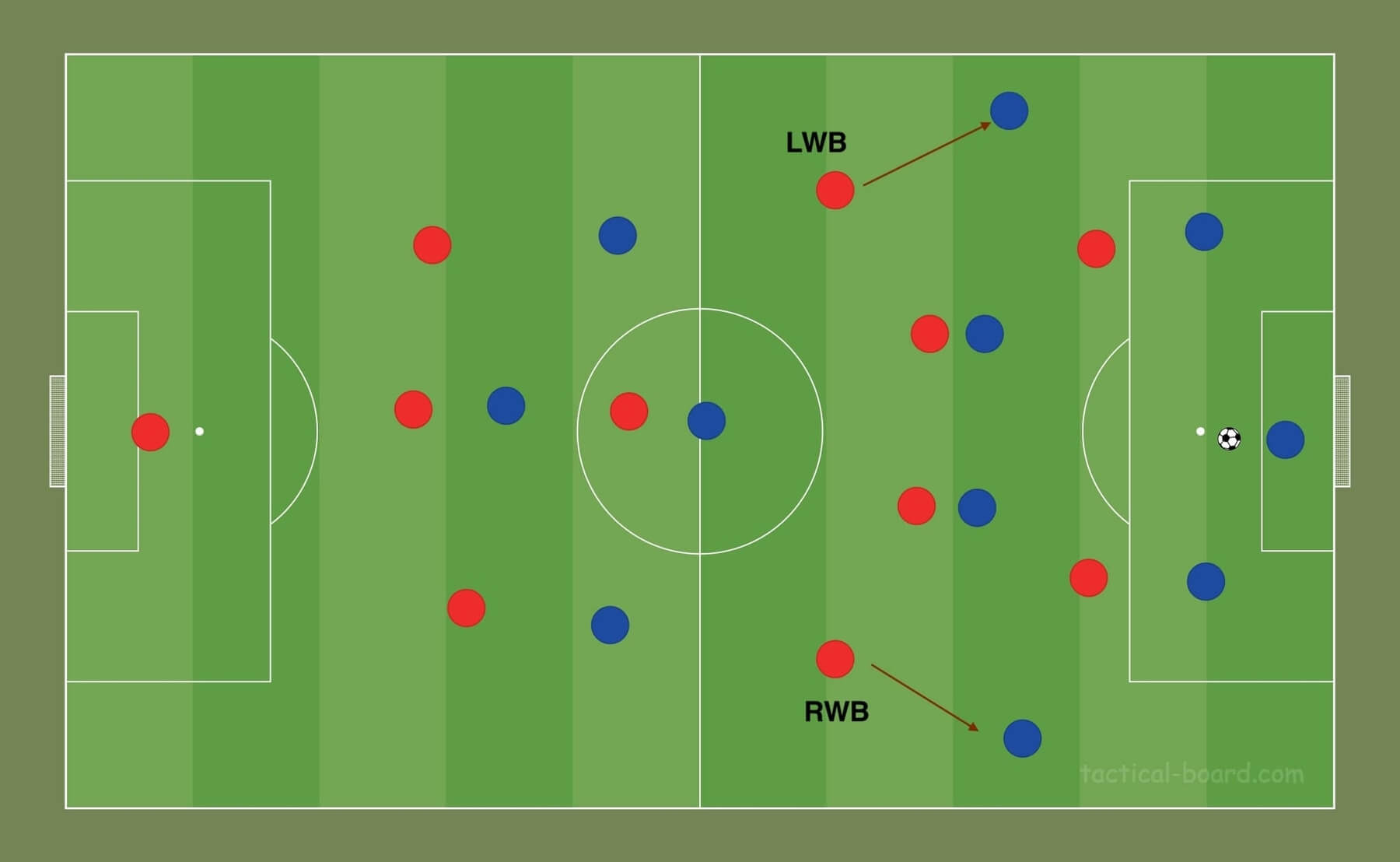
The above figure shows Frankfurt’s man-oriented zonal high pressing shape during the goal kick of an opposition that has setup in a 4-2-3-1 formation. As you can see, both the opposition’s centre-backs and pivots are man-marked by Frankfurt players. Also, the wingbacks have stayed compact to block central passing options but are ready to press the opposition full-back if one of them receives the ball.
This kind of shape forces the opposition goalkeeper to go long where the Frankfurt defenders can dominate in the air and win the possession. In case the goalkeeper passes to his centre-back, Frankfurt’s press becomes aggressive and the lines push higher as they look to block all the short passing options of the opposition man in possession to force him to go long or cause a possession turnover in dangerous areas.
Eintracht Frankfurt have a PPDA of 8.79 this season, which means they allow the opposition to make only under nine passes before making a defensive action. Only Bayern Munich, Bayer Leverkusen, and RB Leipzig press their opponents with higher intensity.
When the opposition can break Frankfurt’s high press and enter the defensive third, the Eagles move into a low block. The 3-4-3 shape transitions into a 5-2-3 as the wingbacks drop into the defensive line. The first two defensive lines stay compact as they tend to force the opposition wide, as shown in the following figure.
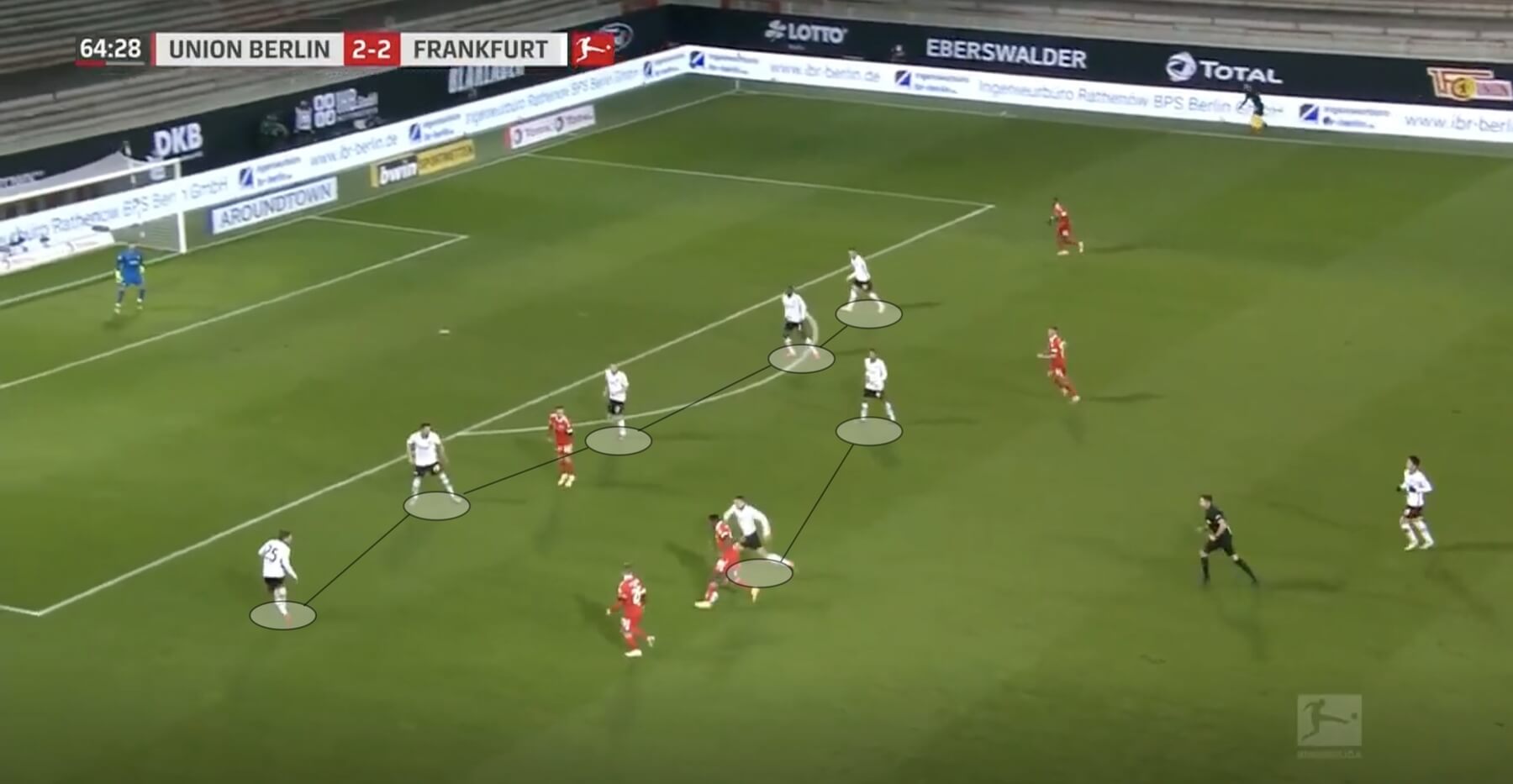
Defensive Weaknesses
Frankfurt has been able to outscore their opponents more often than not in Bundesliga due to Hütter’s impressive attacking and pressing tactics that we saw earlier. However, they are not without weaknesses, especially in the defense. Time and again, opponents have hurt the Eagles by exposing the wider areas, especially in transitions.
One of the reasons for this frailty is related to the attacking structure of their wingbacks. While their high positioning with or without the ball provides attacking ammunition, it also takes away the defensive shield on the flanks as they may get caught out of position during an opposition counterattack.

In the figure above, Ilsanker gave away the ball cheaply during an attack in the opposition half against Union Berlin. As Berlin won the ball, their striker dropped deep while the two midfielders quickly made forward runs to create a dangerous counterattack.
Observe that since Erik Durm was positioned in the attacking third, there was no protection on the right flank which is why Berlin was able to create a 3v2 against a high backline of Frankfurt. Unfortunately, the final ball was not accurate from the striker which was a let-off for Frankfurt.

Frankfurt’s passing accuracy has been 78.8% this season which is not good enough for a side that plays with attacking wing-backs and a high defensive line. They have often been seen giving away possession in the middle and opposition thirds which is something the team has to improve as good counter-attacking oppositions can easily take advantage and expose the high backline in attacking, as Berlin did in the above example.
In the absence of wingbacks, it is possible for the wide centre-backs or a pivot to provide the cover using their one versus one skill. However, quality teams can find a way to maneuver them, as Leipzig showed during their encounter against the Eagles.
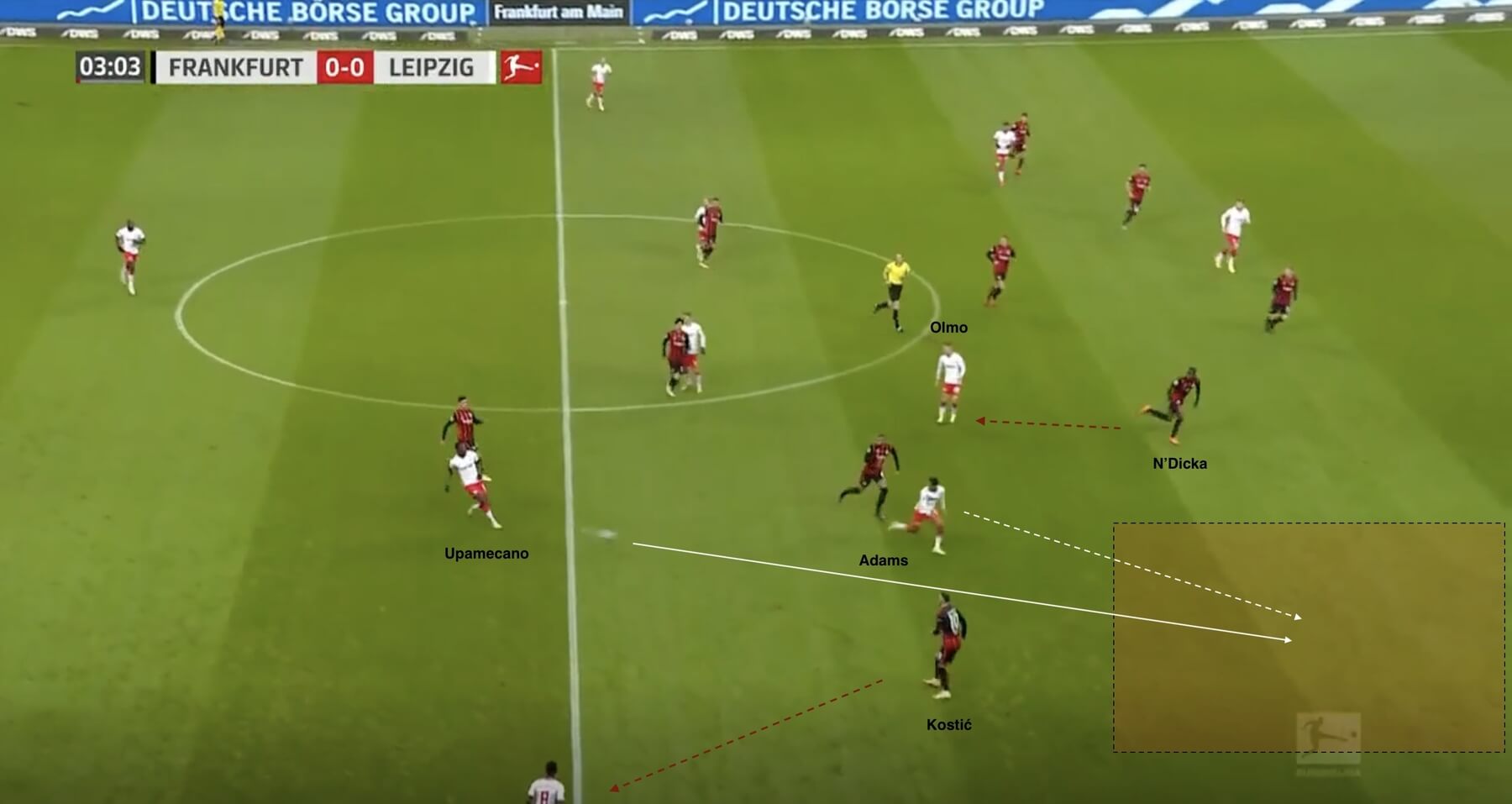
As you can see in the figure above, Leipzig dropped their winger to attract Kostić’s press. Simultaneously, Dani Olmo dropped between the Frankfurt lines in the right half-space to drag N’Dicka out of the defensive line. The combination of these two movements opened up a wide space on the right flank.
Tyler Adams quickly made a run into space. As Dayot Upamecano dribbled past Silva, he was able to provide the ball into the space for Adams in the Frankfurt half. Adams’s cross into the box created a goal-scoring chance for Leipzig.
If Kostić would have stayed deeper to cover N’Dicka, Frankfurt could have had a more stable defensive shape. However, Leipzig kept working into the half-spaces to draw Frankfurt’s wide centre-backs out of their position. In spite of that, Frankfurt’s wingbacks continued to stay high which highlights their structural issue related to the wing-back position.
Conclusion
With just one defeat, Eintracht Frankfurt has been one of the best teams in Bundesliga this season. Adi Hütter’s attacking tactics along with the new fabulous four of André Silva, Bas Dost/ Luka Jović, Filip Kostić, and Daichi Kamada are scoring a plethora of goals. The quartet has so far contributed to 68% of Frankfurt’s total goals.
On the other hand, the defensive tactics of Frankfurt have made them hard to beat. Having said that, their defensive frailties have prevented them to get over the line on 11 occasions where they drew games. If they can iron out their weaknesses, they have the potential to challenge for the Bundesliga title soon. Nevertheless, Hütter deserves huge credit for keeping a Frankfurt side, that is ninth in terms of the squad value, into the top four.
By: Mayur Mehta
Featured Image: @GabFoligno / Oliver Hardt / Getty Images Sport
